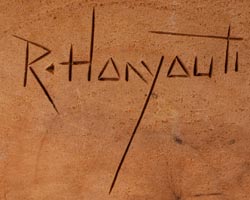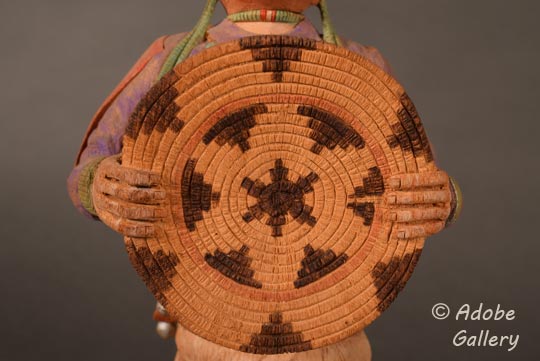Ronald Honyouti Carving of Tasap Kachin Mana [SOLD]
+ Add to my watchlist Forward to Friend
- Category: Traditional
- Origin: Hopi Pueblo, Hopituh Shi-nu-mu
- Medium: cottonwood root, stains and pigments
- Size:
12” Height x 4-½” Width x 4” Depth - Item # C4884D SOLD
 This exquisitely carved version of the Hopi Tasap Kachin Mana is a one-piece cottonwood version of this famous Hopi katsina. She is beautifully carved in precise detail of clothing and accessories. She is featured wearing the traditional Diné style of pleated skirt and velvet blouse. Around her neck she wears a shell at her shirt collar and a traditional turquoise nugget necklace with jaclas. Her earrings are jacklas being worn in the original style for which they were traditional. She is in a dancing position and carries a traditional basket in her hands. On the back side, we see her hair tied in a chonga and strapped with white yarn which spills down her back over the red shoulder wrap that is adorned with three large feathers. A pair of feathers stands upright from the chonga. Around her waist is a traditional Navajo style concho belt. Honyouti embellished the wood pedestal with rock formations, hogans, and vegetation. The doll is signed R. Honyouti on the underside.
This exquisitely carved version of the Hopi Tasap Kachin Mana is a one-piece cottonwood version of this famous Hopi katsina. She is beautifully carved in precise detail of clothing and accessories. She is featured wearing the traditional Diné style of pleated skirt and velvet blouse. Around her neck she wears a shell at her shirt collar and a traditional turquoise nugget necklace with jaclas. Her earrings are jacklas being worn in the original style for which they were traditional. She is in a dancing position and carries a traditional basket in her hands. On the back side, we see her hair tied in a chonga and strapped with white yarn which spills down her back over the red shoulder wrap that is adorned with three large feathers. A pair of feathers stands upright from the chonga. Around her waist is a traditional Navajo style concho belt. Honyouti embellished the wood pedestal with rock formations, hogans, and vegetation. The doll is signed R. Honyouti on the underside.
Ronald Honyouti (b.1955) and his brothers, Brian and Lauren, are the second generation Katsina doll carvers of the Honyouti family. Their father, Clyde, was also a carver of katsina dolls. "Like most Hopi carvers, Ron began making katsinam around age thirteen or fourteen. His major influence was his father, Clyde. Ron noted that Clyde taught by example rather than instruction. Clyde was a traditional Hopi farmer and sheepherder. He reminisced that his father would come home from the fields with a shoulder bag on his back. Within would invariably be a katsina that Clyde was working on while tending the sheep. When Clyde wasn't looking, Ron would sneak a look at his father's current project and learn from viewing the changes in the piece over time." [Walsh, 2019:103]
Ron attended high school in Phoenix and returned to the reservation around 1978. He married and settled down to carving katsina dolls, influenced by his older brother, Brian. The brothers were at the forefront of a developing style of katsina doll carving. They abandoned the current heavy acrylic paints being used by carvers to the use of stains and diluted acrylics resulting in softer color tones on their dolls. [ibid:108]
The Honyouti family was a major feature at Adobe Gallery in the 1980s and '90s. Their katsina doll carvings were displayed and Honyouti family exhibits were frequently presented.
Condition: very good condition
Provenance: this Ronald Honyouti Carving of Tasap Kachin Mana is from the estate of a Santa Fe family.
Reference: Walsh, Barry. "The Great Tradition of Hopi Katsina Carvers 1880 to Present", Rio Nuevo Publishers, 2019.
TAGS: Hopi Pueblo, katsina dolls, Brian Honyouti, Lauren Honyouti

- Category: Traditional
- Origin: Hopi Pueblo, Hopituh Shi-nu-mu
- Medium: cottonwood root, stains and pigments
- Size:
12” Height x 4-½” Width x 4” Depth - Item # C4884D SOLD
Adobe Gallery Recommended Reading
Adobe Gallery Recommended Items
If you are interested in this item, we would also like to recommend these other related items:



